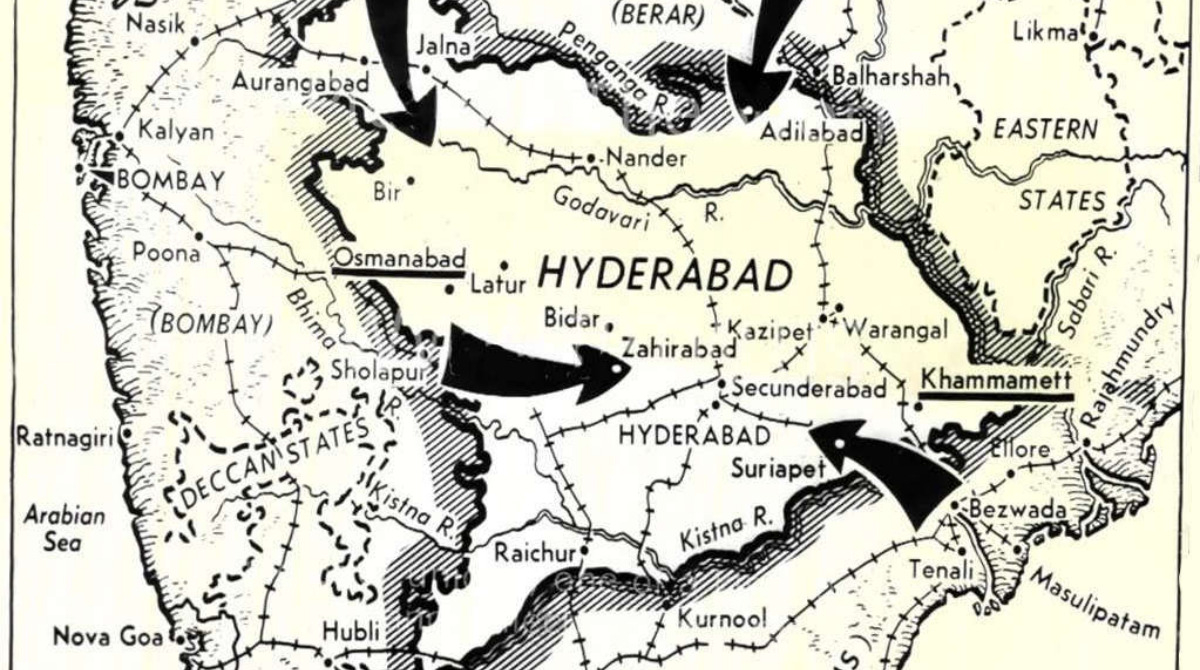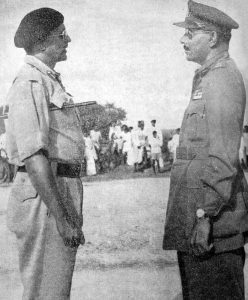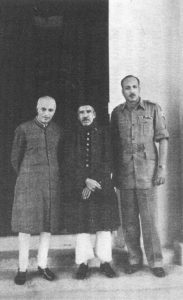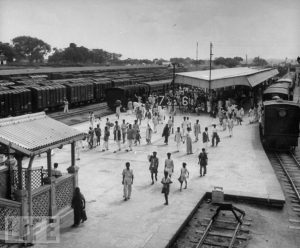It is a historical fact that no contemporary participant or observer used the word ‘liberation’ for the fall of the Nizam's Hyderabad.

The Indian Army launched the strike on Hyderabad from four sides. None of the contemporary participants called it Hyderabad 'liberation’ (Wikimedia Commons)
(Note: This article was originally published on 16 September, 2022, and is being republished on 17 September, 2023, in the wake of the the continuing “liveration vs integration” controversy.)
There has been a contentious debate on how to describe the political event that happened on 17 September 1948, with political parties taking different positions and sometimes even the same party taking two or more mutually contradictory stands simultaneously or changing it over the years. The bone of contention is whether it should be named ‘merger’ or ‘liberation’ or ‘betrayal’ or ‘national integration’.
After launching the strike on Hyderabad from four sides, two being major thrusts, and securing the first victory at Naldurg fort on the Sholapur-Hyderabad route on 13 September, the Indian Army moved steadily and reached the outskirts of the capital within four days.
On the evening of that fateful Friday — 17 September 1948 — Mir Osman Ali Khan, the seventh Nizam of the Asif Jahi dynasty that had ruled Hyderabad since 1724, addressed his “beloved people” over Deccan Radio to announce the end of his rule. He said: “[My] government has tendered resignation… I have ordered a ceasefire to my troops and have also ordered a ban on the Razakars and allowed the Indian Union to occupy Bolarum and Secunderabad tomorrow.”

The commander-in-chief of the Hyderabad State Forces surrenders to the Indian Army’s Major General JN Chaudhuri in Secunderabad (Wikimedia Commons)
He also announced a caretaker ministry till he got “an opportunity to appoint a prime minister” and hoped that “it would not be difficult to arrive at an arrangement with the Government of India under which my people … can live in peace and harmony”.
Maybe he was too diplomatic or did not have a sufficient intelligence report on what was going to happen. Anyway, he might not have expected that the naming of this day would become a hot topic a few decades down the line. At least till his death in 1967, he never witnessed any debate.
The actual surrender of the Hyderabad Army to the Indian Army, or the fall of Hyderabad, took place at 4 pm on 18 September.
It is a historical fact that none of the contemporary participants and observers used the word ‘liberation’. The action was officially called Operation Caterpillar or Operation Polo. In popular parlance it was Police Action, though it was indeed a military action.
Merger, annexation, accession, attack, action, invasion, military operation, Nizam’s surrender, and end of Asaf Jahi rule were the descriptions used at that time.
To give a few examples, while the Times of India masthead said, “Hyderabad forces surrender today”, the Indian Express said, “Hyderabad surrender accepted” and the New York Times said, “Hyderabad resists 3-prong Invasion by Army of India”. Even Telugu newspapers like the Andhra Patrika and Andhra Prabha did not call it a “liberation day”.

Indian Prime Minister Jawaharlal Nehru (left) with Nizam Mir Osman Ali Khan (centre) and Major General JN Chaudhuri (Wikimedia Commons)
Nor did the politicians and officials behind the action call it liberation of Hyderabad. VP Menon, who perhaps had the maximum possible information on the amalgamation of various princely states in the Indian Union, in his book The Integration of Indian States did not describe it as ‘liberation’ of Hyderabad State, but used the words ‘march’, ‘action’, and ‘attack’.
The Socialist Party, which was a major outfit in pre-1948 Hyderabad, published ‘Hyderabad Problem – The Next Step’ immediately after the Police Action and did not call it ‘liberation’. ‘India’s Police Action against Hyderabad’ published in 1949 by Vandemataram Veerabhadra Rao and Ramchandar Rao brothers also did not use that word, but captioned the pictures of Sardar Patel, KM Munshi, and Major General JN Chaudhuri as “liberators”.
Thus even a cursory look at the publications till the late 1970s shows that the date was not attributed the qualification of ‘liberation’. At best it was only merger or integration into the Indian Union or ‘forced annexation’ as termed by Mir Laiq Ali, the last prime minister of Hyderabad.
But then how did this name enter the popular imagination?
From the late 1970s, the RSS and its affiliates began calling it ‘Liberation Day’, in tune with their political belief of a “Hindu population liberated from autocratic Muslim rule”. And the feeble voice grew in strength by 1998, when the then Union Home Minister LK Advani addressed a public meeting in Hyderabad on the occasion of the “Golden Jubilee of Liberation”.
Now his successor Amit Shah is coming to celebrate the “Diamond Jubilee.”
But the facts are not on their side.

The Secunderabad railway station, part of the Nizam’s Guaranteed State Railway, in 1948 (Wikimedia Commons)
Hyderabad was not a Muslim state, though Islam was the personal religious belief of the ruler. The king was supported by hundreds of Hindu feudal landlords and was also patronised by the British empire. Describing it as a theocratic state would be a travesty.
Of course in the last couple of years, a vigilante force called Razakars was raised with state patronage. But even that supposed Muslim force had several ‘Hindu’ foot soldiers and stayed and feasted in ‘Hindu’ landlords’ fortresses to attack people supporting the ongoing Communist peasant rebellion.
The Sangh Parivar managed to humble many other parties by posing an either-or challenge: “If you do not call it ‘liberation’, then you are on the side of Razakars.” Afraid of being branded pro-Razakar, many parties chose silence or began accepting the Hyderabad ‘liberation’ narrative.
But 17 September did not liberate people from feudal exploitation and oppression against which they were fighting. The king continued as head of the government for two more years and was then made Raj Pramukh till 1956. Though some of his ownership of large tracts of land was abolished, he was paid huge compensation. He was allowed a hefty privy purse, till it was done away with in 1969.
The Union Army entered the villages and reinstalled the landlords who left due to the people’s struggle. Their lands were given back. The landlords, who till yesterday were faithful to the Nizam and wore rumi caps, now changed to Gandhi caps and continued their oppression.
At least 3,000 communists and peasant activists were killed by the Union Army from September 1948 to 20 October 1951 (the date when the Communist Party withdrew its armed struggle). The Pandit Sundarlal Report said at least 40,000 ordinary Muslims were killed with the connivance of the Union Army or otherwise.
Thus, from any vantage — the contemporary records or ruling class or people — none of the names for 17 September 1948 completely work. It was neither respectable merger, nor liberation, nor betrayal, nor integration.
Shakespeare wondered ‘what’s in a name’, but naming 17 September is complex, difficult, and associated with political correctness and opportunism.
(N Venugopal is the Editor of Veekshanam, Telugu monthly journal of political economy and society. These are the personal views of the author)

Jul 26, 2024

Jul 26, 2024

Jul 26, 2024

Jul 25, 2024

Jul 25, 2024

Jul 25, 2024